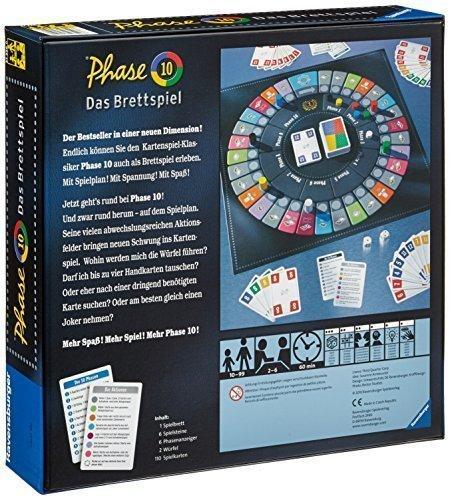Phase 10 as a board game – the classic with a difference.
We already have the classic phase 10 presented . With the Phase 10 board game version, the classic has been given a completely new and varied coat of paint. The principle remains the same, variety is created by the large game board with the various options for receiving, exchanging or disposing of cards.
Download the instructions as a PDF for free
Phase 10 board game rules & instructions
- The package includes:

- 1 game board
- 6 large game pieces
- 6 small game pieces (phase indicators)
- 2 dice
- 110 playing cards (including 96 number cards, 6 German phase overview cards, 8 international phase overview cards)
Objective of the phase 10 board game
Regardless of whether it is a classic or a board game, the goal is always to be the first to put the last phase out and get rid of the cards in hand.
preparation
As with every game board, this one is placed in the middle of the table. Each player receives the token, the phase indicator and the phase / overview card in his chosen color. In addition, everyone will be dealt 10 cards if these are shuffled accordingly. In addition to the game pieces, there is another difference to the classic game: 5 cards are turned up and placed on the discard pile. Only the top card can be seen. All other cards go on the receiving pile.
The move
Similar to the classic, a play proceeds according to a fixed pattern:
First you roll the dice (with both dice). Let’s say a 1 and a 3 were rolled. The player now decides whether to move one field forward, or 3. He decides this when he has found out what the meaning of the respective field has. Some spaces require a “classic” phase 10 move (draw a card and discard one). Some other fields represent a joker, for example, or the possibility of choosing a card from the discard pile. A list of the individual symbols and colors can be found on the back of the phase / overview map. It is always important that fields that are already occupied are not included in the count. So if we assume that field number 3 is occupied, the following field is counted as 3rd.
After the decision for a square has been made, the move must be made. The player takes the card (s), looks at how he can integrate it into his current phase and ideally puts it down completely in front of him. If he cannot put it down yet, he must put a card that he no longer needs on the discard pile and it is the next player’s turn.
When the player has put out his phase
Now it is time to get rid of the remaining cards in hand. This is done by applying to one’s own phase or to others. Whenever the player makes a move, he still carries out his chosen action and can accordingly place cards over and over again. When he has finished his turn, he must discard a card.
If the player has no cards in hand, this round is over. All players who have completely placed their phase in front of them move their phase hands one space further. Participants who were unable to put down have the opportunity to keep up to 5 of their existing cards. At the beginning of the new round, the card sheet is filled with 10 cards for each player.
Download the instructions as a PDF for free
Specialty: If a player puts his phase out and can place all of his hand cards directly, he has made a “hand”. This means that he may move 2 spaces further with his phase pointer. So he skips a phase.
The entire process is repeated until the 1st player has finished the 10th phase. He then also won. In this variant of the Phase 10 game, no points are calculated after each round.
